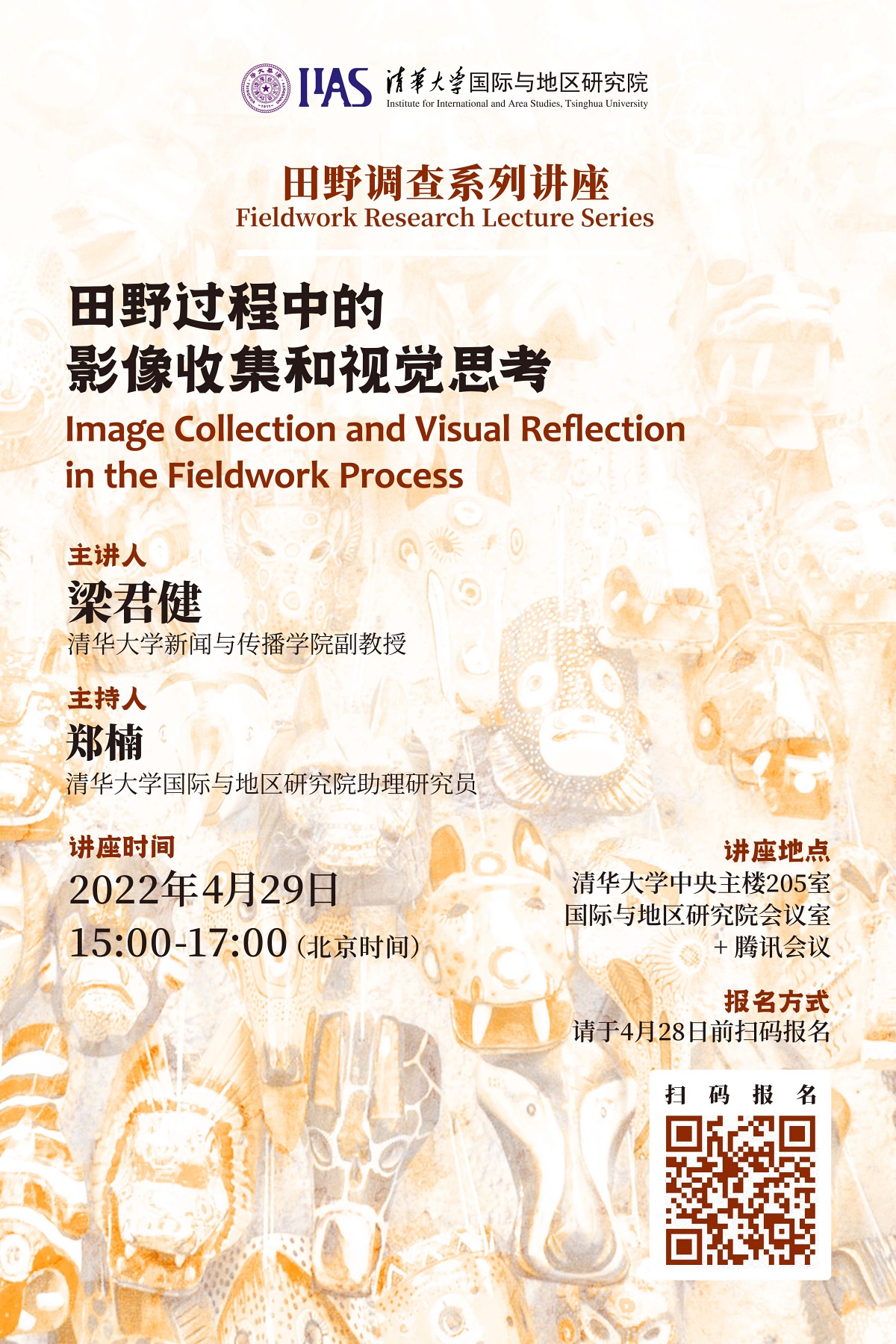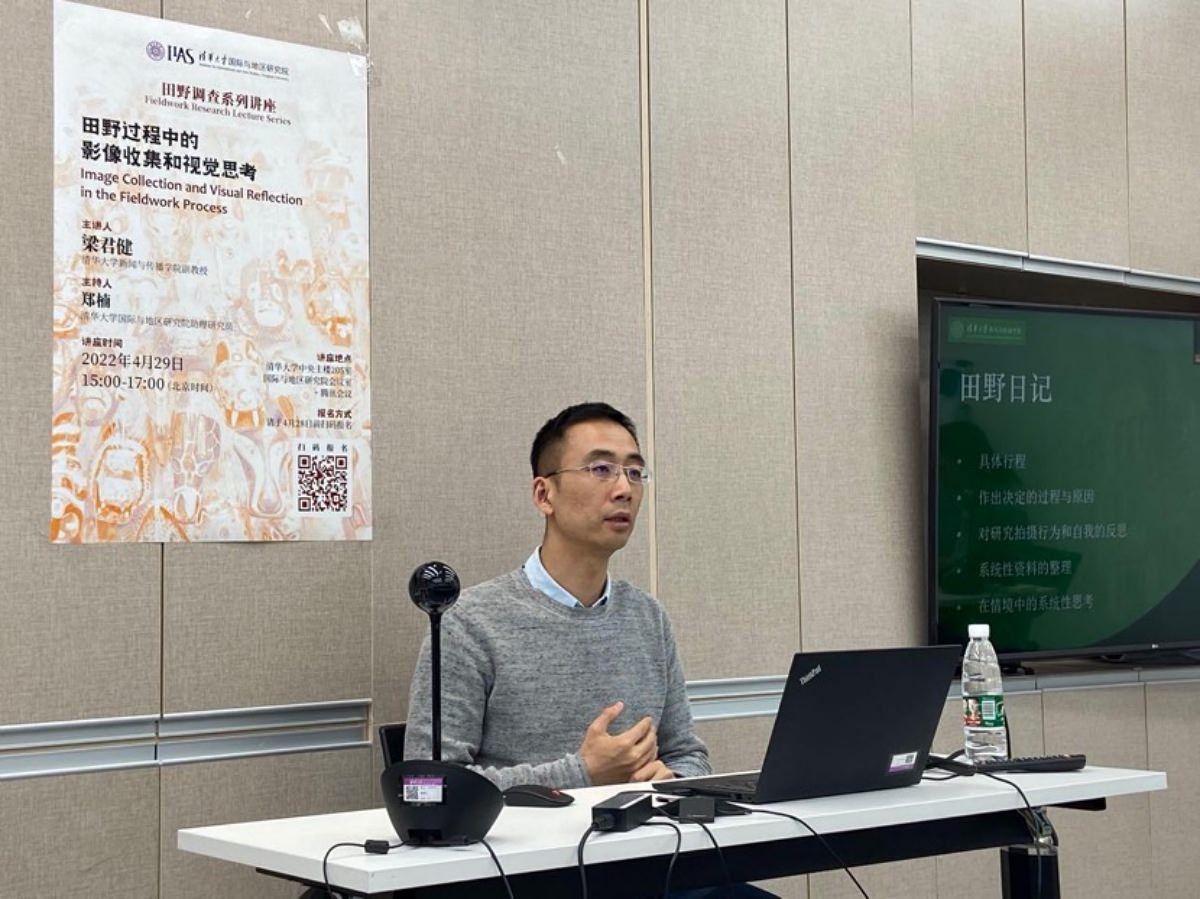
On April 29, 2022, the Institute for International and Area Studies (IIAS) of Tsinghua University successfully hosted the second lecture in the Fieldwork Research Lecture Series. The lecture entitled “Image Collection and Visual Reflection in the Fieldwork Process” was held onsite and online via Tencent Meeting simultaneously. It was delivered by Liang Junjian, Associate Professor from the School of Journalism and Communication at Tsinghua University and presided over by Zheng Nan, a research assistant at the IIAS. More than 300 faculty members and students from Tsinghua University, Peking University, Shanghai Jiao Tong University and other universities and research institutes at home and abroad attended the lecture.
At the beginning, Dr. Liang Junjian started with expounding the significance of fieldwork to anthropology and regional culture research, and the advantages brought by visual means and visual reflection to fieldwork, and then introduced some basic methods and concepts of anthropological fieldwork, including those from Firth and Malinowski. He summarized the process of anthropologists’ thorough fieldwork in different ways and stages, such as empirical test, participatory observation and linguistics to enrich field understanding, and gave specific suggestions on how to carry out anthropological research.
After that, Dr. Liang elaborated through operation guide, image mode and visual reflection about how fieldwork practitioners who have been trained with theories and methodologies conduct field filming and apply the filmed materials.
Firstly, Dr. Liang explained William Bateson’s four suggestions on how to film in the field, i.e. film as much as possible, make filming a routine and get the research subjects used to being filmed, record interpersonal interactions and real scenes, and take interventional shots to get specific contents. In the process of specific scene filming, attention should be paid to two visual elements, i.e. the field of view including “quantity of information” and “distance”, and the structure of “diachronic sequence” and “synchronic sequence” reflecting the correlation between different photos. In addition, filming and transcript writing should be done at the same time, and the latter includes the immediate recording of filming scenes and the supplement and preliminary analysis and judgment during reexamination of materials. Dr. Liang shared his field diary cases and documentary clips, and recommended the audience to develop the habit of recording materials, otherwise the value of unsorted materials would be sharply reduced. Furthermore, field diary is also very important to help with reexamination and summary, he emphasized.
Secondly, Dr. Liang introduced some considerations about the image modes, that is, how to look at images as well as the theoretical assumptions and relations behind research and images. He pointed out that constructivism, critical theorist and post-positivism are the three most typical roles in humanities and social science research, which can be divided into two categories: information & specimen and observation & interpretation. He also took advantage of practical cases to introduce the participatory and sharing filming and its promoting effect on research.
Thirdly, Dr. Liang explained the relevant issues of visual reflection from two aspects of cultural epistemology and anthropological visual research, and stated that anthropology is constantly adjusting the existing epistemology in the development process.
After the lecture, Dr. Liang interacted with onsite and online participants on how to avoid “filming violence” against others, whether videos published on social media and online platforms can be a source to collect participatory images, and how to understand new phenomenon in the digital age from the perspective of visual anthropology.

Dr. Liang Junjian is a documentary director, associate professor and doctoral supervisor from the School of Journalism and Communication at Tsinghua university, and a visiting scholar of the Department of Anthropology, University of South Carolina. His main research fields include film and television dissemination, visual culture, visual anthropology, media and society. He currently teaches courses including Countries and Societies through the Lens, Film and Television Production, Fresh Vision Workshop, etc. Dr. Liang has published a number of articles on *People’s Daily*, *Guangming Daily*, *Contemporary Film*, *Film Art*, *Journal of Beijing Film Academy*, *China Television*, *Journalism Review*, *Modern Communication* (Journal of Communication University of China), *Ethnic Arts Quarterly*, and *Communication & Society*. He is the director of multiple documentaries such as *A Piece of Xuan Paper*, *Himalaya: Ladder to Paradise*, *Seasons Greeting*, etc. He once reported his research on film anthropology and ethnographic film creation at the IUAES World Congress, the Royal Anthropological Institute Film Festival and other academic conferences.
Edited by: Wang Qin
Typeset by: Cheng Yao
Proofread by: Zheng Nan




